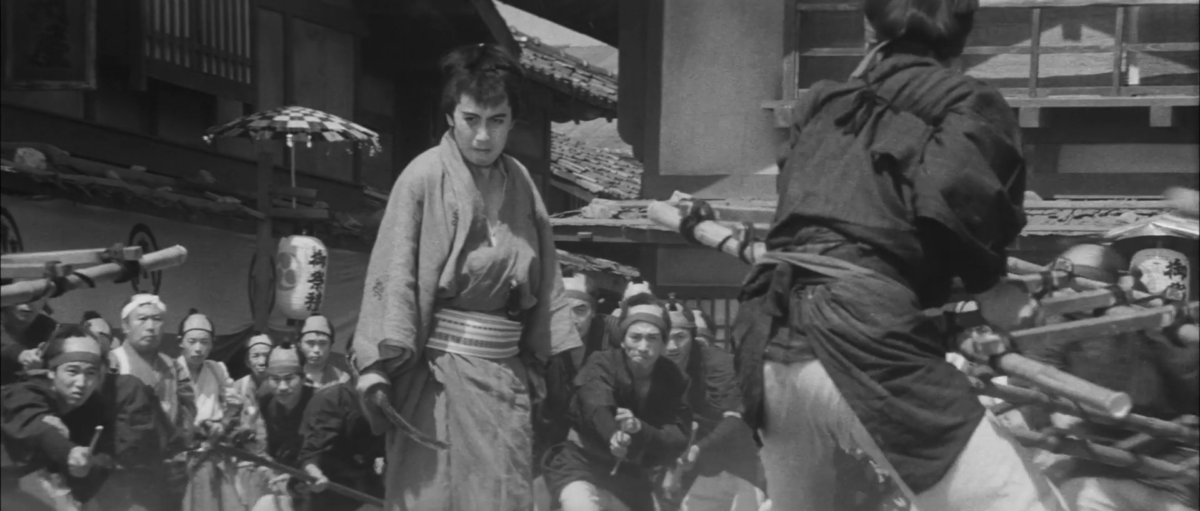Last Updated on October 2, 2020 by rob
A samurai from the powerful Iwashiro clan is killed by Shinbei and Jurota, two members of the smaller Minazuki clan. But Shinbei is the only son of Minazuki clan leader, Katagiri. In an effort to save his son’s life Katagiri begs samurai Takuma (Raizo Ichikawa) to take the blame. Takuma reluctantly agrees to go into exile for a year with the promise that he can then return and marry his fiancee Namie (Kaoru Yachigusa). But during his year away Katagiri and his son die and Jurota seizes power. When Takuma returns to his clan Jurota denies all knowledge of the bargain. Now a fugitive hunted by both clans a disillusioned Takuma goes on the run as Jurota plots to kill him and seize his beloved Nami for himself.
I don’t think there’s a single drop of blood in it but if thrillingly visceral sword fights that culminate in an extended showdown between star Raizo Ichikawa and about 200 samurai are your cup of tea – and they certainly are mine – then I would strongly recommend The Betrayal. It’s a briskly paced yarn whose theme is the bankruptcy of the samurai’s much vaunted ‘code of honour’. Illustrative of this façade is that it’s strongly implied the idea of making Takuma the fall guy for Shinbei and Jurota’s transgression comes from none other than Iwashiro clan’s own chamberlain whom Katagiri visits in order to beg mercy for his son! As the scales fall from Takuma’s eyes all hell breaks loose as the now decidedly bitter samurai cuts a swathe through the corrupt officials and samurai ranged against him while struggling with the dilemma of whether to give in to his darkest impulses.
This theme is expertly personalised as our hero encounters a series of events that seem designed to confirm all his worst suspicions about human nature and it’s one of the aspects that elevates the film to the status of a superior entry in the genre. But just when things seem at their bleakest a wounded Takuma is rescued by a bar hostess named Shino whose kindness to him shows that good people do indeed exist. For Takuma however, it may already be too late. Whilst he can’t become the monster he’s seen in others (there’s a great moment where he turns on Shino with the intention of raping her but can’t bring himself to do it) neither can he be the man he once was. Chishi Makiura’s stark cinematography means that Raizo’s delicate features have never looked more haunted or tortured than they do here. We really feel for him not just because the situation he finds himself in is so unfair but because in the brief early scenes of domestic bliss between Takuma and Namie we sense acutely the value of what’s been lost.
A surprise reunion between the lovers – in which the former finds himself in his cups as bodyguard to a sleazy crook named Gorozo, while the latter has escaped from Jurota to work as a prostitute (in a nice touch Namie tells the madam that she’ll only take samurai as clients) – is a powerhouse moment showing us that the pair’s love for each other remains unshakable. By the time the climax arrives one is thoroughly invested in the desire to see Takuma and Namie survive together. In a jaw-dropping climax Takuma finds himself betrayed by Gorozo and forced to fight for his life against several hundred samurai from the Iwashiro and Minazuki clans! Despite the lack of blood one of the film’s great accomplishments is to make you feel every single thrust and parry of the ensuing swordfight as the initial speed of Raizo’s defence (featuring the actor in some fantastic lengthy single takes) gradually gives way to weariness and exhaustion. The ebb and flow of battle, the way a snatched gulp of water or a moment’s rest flat out on the ground while adversaries hesitate, these are the moments that can make the difference between life and death and they’re vividly socked over here.
And there are some fantastically dynamic movements within the frame. The sweeping strokes of Raizo’s swordsmanship have such a grim beauty to them (as when he cuts down a half dozen attackers while lying flat on his back!) Best moment; midway through the final showdown, Takuma having to physically prise his hand off his broken sword, one rigid finger at a time, so tightly is it gripping the handle! In some ways this is actually a much bleaker movie than the 1925 original, Orochi, which at least allowed its put upon hero salvation. Although Takuma and Namie survive, gazing at each other amidst a landscape of corpses, this hero seems too far gone, so crushed in his soul he’s little more than – as he even calls himself at one point – a dead man walking. But you really hope that with Namie beside him he’ll somehow pull himself back. He deserves it.



